
|
The Man With a Movie Camera (1929,
Soviet Union) (aka Chelovek S Kinoapparatom, or Человек C
Kино-Aппаратом)
In Soviet director Dziga Vertov's quintessential experimental,
avante-garde film - an excellent example of a "city symphony" documentary,
and regarded as "pure" visual cinema without a plot, action,
setting or dialogue (or intertitles); the use of radical hyper-editing
techniques, variable camera speeds, dissolves, special visual effects,
stop-motion, wild juxtapositions of images, freeze frames, split-screens,
and super-imposed double exposures - a precursor of Koyaanisqatsi
(1982) and MTV videos:
- the many day-in-Soviet-life views of Moscow, Kiev,
and Odessa, of Russian workers and machines, after the arrival
of a camera man (Mikhail Kaufman) (with an old-styled hand-cranked
camera with a tripod) in a very-static and dead city, that suddenly
became enlivened and energized by his arrival
- the film's opening - an empty film theatre, where
the seats folded down by themselves, and the audience entered to
watch a film (this film!)
- the double-exposure, camera-trickery shot of a cameraman
setting up his camera atop another camera
- the fast-moving, free-association of images (over
1,700 shots and scenes of everyday life), all presented with an average
of 2.3 seconds per shot length - was wholly unprecedented in the
late 1920s
|
Free-Association of Film Images
|

|
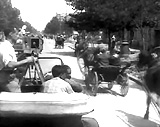
|
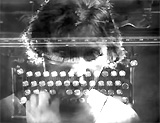
|
- the images: street scenes, close-ups of machinery,
architecture, nature, beaches and beach crowds, workers, birth/wedding/death-funeral,
static shots (a typewriter keyboard, a store window display), etc.
- some images were displayed as dissolves, split-screens, in slow-motion,
or as super-impositions or double exposures
- the best example of stop-motion were the playful views
of the tripod-camera acting anthropomorphically, by rotating its
camera-head around, and then beginning to walk away on its three
legs
- the ending, including some views of the actual process
of the editing of the film by the cameraman, accentuated by the super-imposed
image of a human eye looking out of a camera lens
|
The Ending
|

|
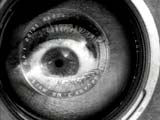
|
|

Camera Trickery
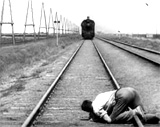
Filming an Oncoming Train
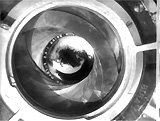
Movie Camera Lens

Birth of Baby

Eyeball Reflection

Stop Motion of Anthropomorphic Camera
|







